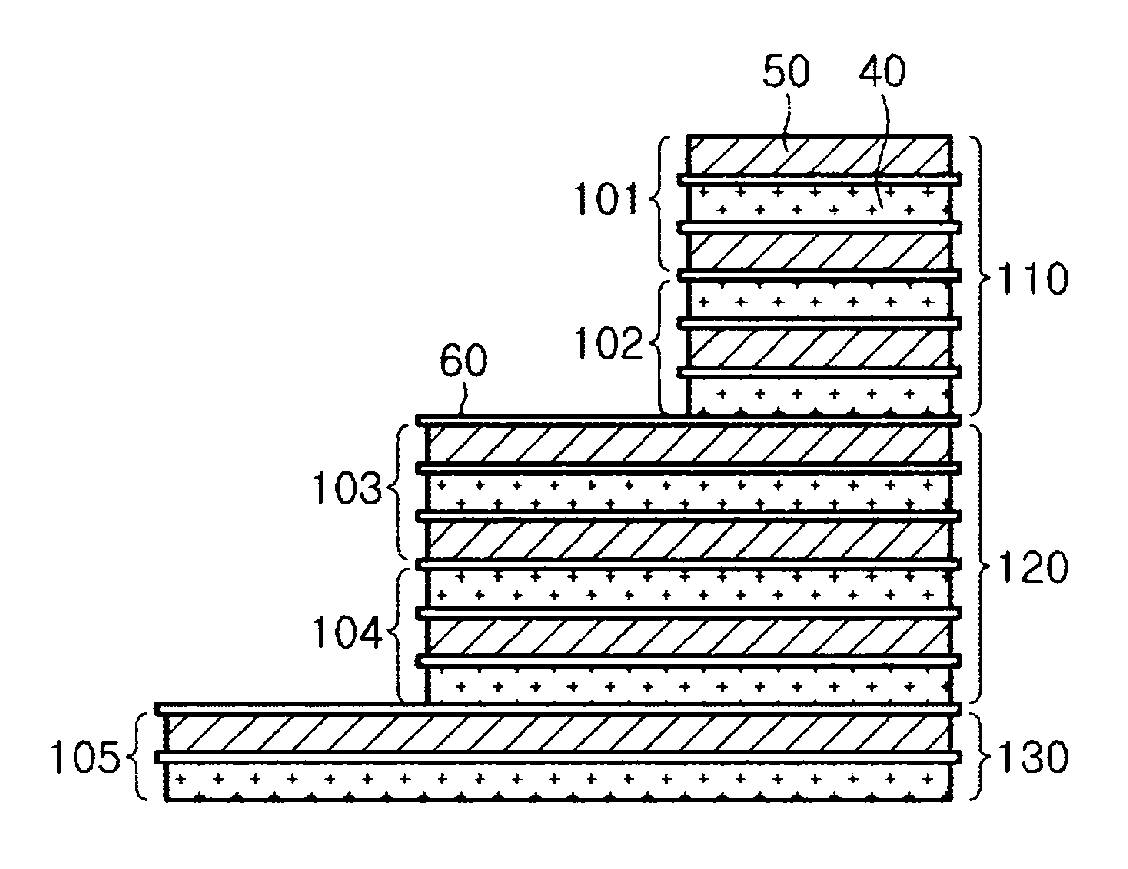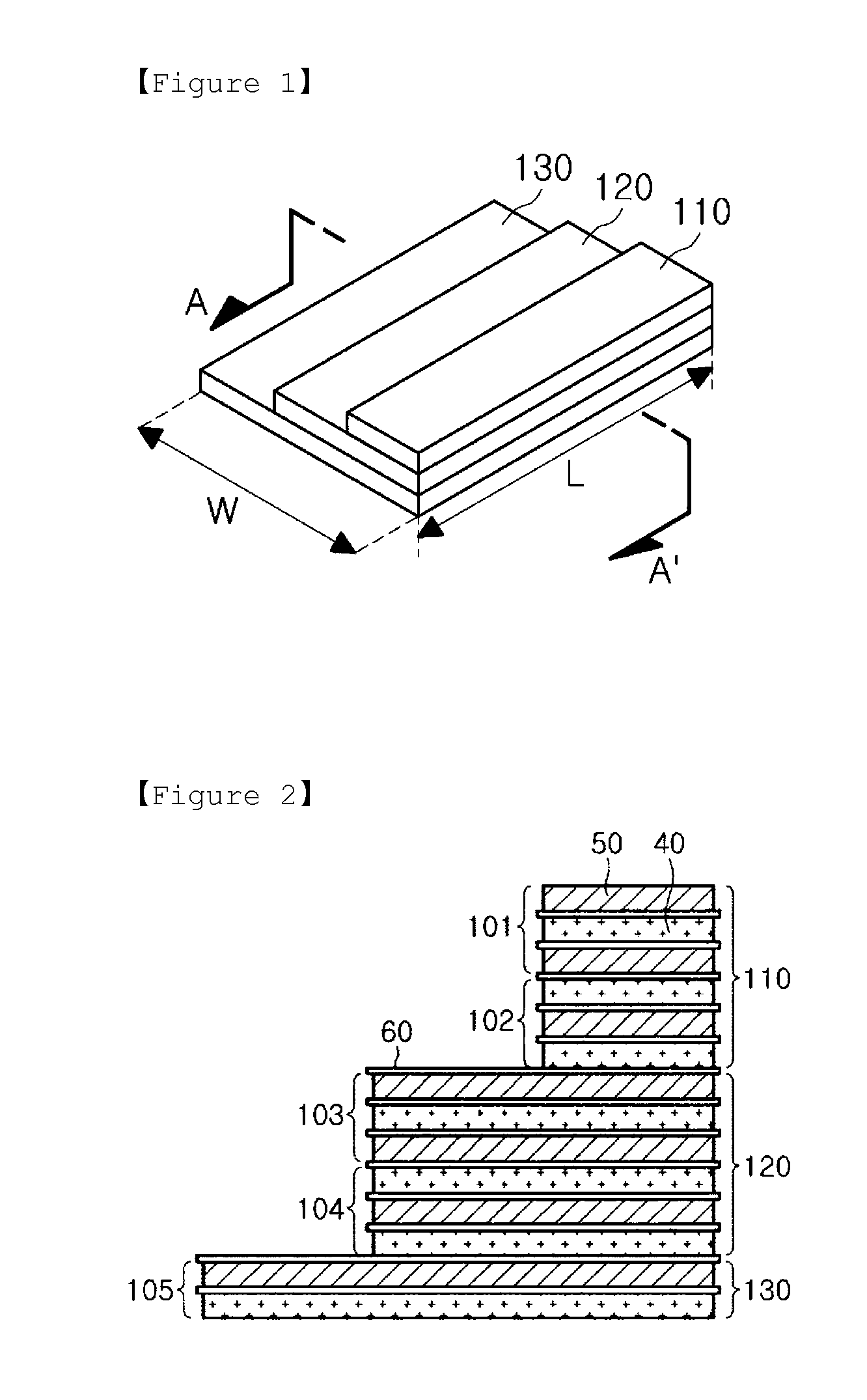Electrode assembly including electrode units having the same length and different widths, and battery cell and device including the electrode assembly
a technology of electrode assembly and electrode unit, which is applied in the direction of cell components, flat cell grouping, sustainable manufacturing/processing, etc., can solve the problems of many limitations in battery design, limited shape, and low degree of design freedom of batteries, so as to maintain the capacity and durability characteristics of electrode assemblies, reduce dead space, and improve the degree of design freedom of electrode assemblies
- Summary
- Abstract
- Description
- Claims
- Application Information
AI Technical Summary
Benefits of technology
Problems solved by technology
Method used
Image
Examples
example 2
[0156]The positive electrode (A) and the negative electrode (A) were cut into 100 mm×150 mm, and were stacked with a separator being interposed therebetween to form an electrode unit. Then, a relatively small-area electrode unit was formed by cutting the positive electrode (A) and the negative electrode (B) to be 80 mm×150 mm and stacking the positive electrode (A) and the negative electrode (B) with a separator being interposed therebetween. The relatively large-area electrode unit and the relatively small-area electrode unit were stacked to form an electrode assembly.
experimental example 1
[0160]Electric capacities and thickness variations of the electrode assemblies of Examples 1 and 2 and Comparative Examples 1 and 2 were measured after the electrode assemblies undergone 500 charging and discharging cycles.
[0161]The electric capacities were measured under the following charging condition and discharging condition, and charging and discharging were carried out at intervals of 10 minutes.
[0162](1) Charging condition (A): charging to a voltage of 4.2 V or 4.35 V at 1 C rate in constant current mode, and then charging in constant voltage mode until a charging current reaches 1 / 20 of minimum battery capacity
[0163](2) Discharging condition (B): discharging to a voltage of 3 V at 1 C rate in constant current mode
[0164]The thickness variations of the electrode assemblies measured by measuring the thicknesses of the electrode assemblies each time after one charging and discharging cycle.
[0165]Measurement results are shown in FIG. 12. Referring to FIG. 12, in the case of the ...
experimental example 2
[0166]The positive electrode (A) and the negative electrode (E) were cut into 80 mm×150 mm, and were stacked with a separator being interposed therebetween to form a small-area electrode unit.
[0167]Then, negative electrodes 1 to 8 were manufactured in the same manner as in Manufacturing Example 3, except that the thicknesses of the negative electrodes 1 to 8 were varied, as shown in Table 2. The negative electrodes 1 to 8 had reversible capacities as shown in Table 2. Thereafter, the positive electrode (A) and the negative electrodes 1 to 8 were cut into 100 mm×150 mm, and were stacked with separators being disposed therebetween, so as to form large-area electrode units 1 to 8
[0168]Then, small-area electrode units were placed on the large-area electrode units 1 to 8, respectively, so as to form electrode assemblies 1 to 8.
TABLE 2Small-N / Parea PreversibleN / Pthick-ReversiblecapacitythicknessLarge-nessesPorositycapacityratios atratios atNo.area N(μm)(%)(mAh)interfacesinterfacesEA 1N 14...
PUM
 Login to View More
Login to View More Abstract
Description
Claims
Application Information
 Login to View More
Login to View More - R&D
- Intellectual Property
- Life Sciences
- Materials
- Tech Scout
- Unparalleled Data Quality
- Higher Quality Content
- 60% Fewer Hallucinations
Browse by: Latest US Patents, China's latest patents, Technical Efficacy Thesaurus, Application Domain, Technology Topic, Popular Technical Reports.
© 2025 PatSnap. All rights reserved.Legal|Privacy policy|Modern Slavery Act Transparency Statement|Sitemap|About US| Contact US: help@patsnap.com



